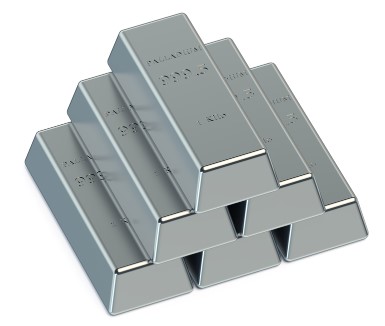Geology of Palladium
Learn interesting geological facts about palladium - where to find it, top producers, and why to invest
| Physical Properties of Palladium | |
|---|---|
 | |
| Composition | Palladium, with trace amounts of other elements like iron and platinum |
| Chemical Classification | Native Element |
| Chemical Composition | Pd |
| Atomic Number | 46 |
| Color | White, steel-gray |
| Streak | Silver-gray, shiny |
| Luster | Metallic |
| Hardness | 4.75 |
| Specific Gravity | 12.02 |
| Fracture | Elastic |
| Rock Type | Igneous |
| Crystal System | Isometric |
| Modern Uses | Automotive, electronic, medicine, jewelry, investment |
Palladium—along with ruthenium, osmium, iridium, and platinum—is categorized into a group of elements known as platinum group metals (PGMs). As a lustrous silver-white metal, palladium often has a cubic crystalline structure. At ordinary temperatures, it resists corrosion through air and the action of acids.
Palladium has also developed a great reputation for absorbing hydrogen, which can be as much as 900 times its own volume. Continue reading to learn geological facts about this precious metal and why you should consider investing.
Modern Applications of Palladium
Corrosion resistance makes palladium a key player in the alloys used for low voltage electrical contacts. You can finely divide palladium into various forms to make a catalyst that helps speed up hydrogenation, along with hydrogenation reactions.
Palladium has also seen extensive use among jewelers, who have used it for some alloys known as “white gold.” Palladium has also seen wide use for springs, watch bearings, mirrors for scientific instruments, and balance wheels.
In the field of dentistry, palladium alloys with gold, silver, and copper can be found. Palladium salts have also seen wide use in electroplating.
Where Can You Find Palladium in the US and the World?
In the United States, you can find palladium in Montana’s Stillwater Mine, which is the only palladium and platinum producer in the nation. Elsewhere in the Western Hemisphere, you can find uncombined palladium in Brazil. Most of the palladium that gets extracted is a byproduct of nickel refinement.
Some of the other places in the world where palladium is mined include:
- Russia
- Ethiopia
- Australia
- Canada
- Zimbabwe
- Italy
- Germany
- France
- South Korea
- South Africa
Many times palladium gets associated with platinum and platinum group metals. Sometimes it has been recovered in copper and nickel deposits in South Africa and Canada.
Estimated Quantity of Palladium on Earth
Palladium is estimated to exist at one to 10 parts per trillion, making it one of the planet’s rarest elements. Most of the time, this substance will occur in native form, and it does not combine with other elements.
South Africa and Russia produce around 93 percent of the world’s palladium supply.
All platinum group elements form through the cooling of magma. These ore deposits cool from the magma and later become palladium and other elements of this nature. When you put all six of the platinum group elements together, it makes up only 0.0005 parts of the earth’s crust.
The Geological Signs of Palladium
When we look at the geological signs and characteristics of palladium, you have a lot of similarities to the platinum deposits found near Lac des iles, Quebec, Canada. The regional structures act a lot like feeders. Compared to some of the other metals, palladium has little impact on the environment when released.
How Palladium Compares to Other Precious Metals
Palladium is a great method to invest in precious metals because it costs less than gold. Between 2010 and 2014, palladium saw the greatest increase in value compared to silver, gold, and platinum. In fact, this precious metal almost doubled in price from $419 in 2014 to $815 in 2014. Palladium makes a good purchase because of the balanced middle ground with more affordable pricing than platinum or gold.
If you are interested in buying palladium as an asset, you can choose to buy it in either coins or bars, or as jewelry to wear. Check out our palladium bullion for sale.





